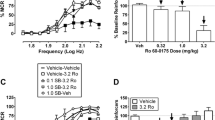Abstract
Progressive-ratio (PR) schedules, which have been widely used to study the reinforcing efficacy of various reinforcers (in particular IV psychostimulants), have been very seldom applied to the study of positively reinforcing electrical brain stimulation (EBS). In the present study, rats were required to emit a progressively increasing number of lever-presses (3,4,6,7,9,11,14,16, etc.) for access to successive reinforcers (periods of VTA self-stimulation). Each period of self-stimulation consisted of ten trains of square pulses of EBS; each train was available under a continuous reinforcement schedule. The number of periods of EBS earned during a session was deemed the breaking point (BP). After acquisition and stabilization of self-stimulation, a study was carried out to verify that changes in the strength of the EBS (i.e. changes in the frequency, the intensity or the pulse duration, one parameter at a time) induced changes in the BP. The effects of IP pretreatments with d-amphetamine, the dopamine D3/D2 receptor agonist 7-OH-DPAT and haloperidol were then assessed. Decreases in the strength of EBS decreased the BP. However, increasing the strength above training values resulted in minimal increases in the BP. d-Amphetamine (0.25–1 mg/kg) dose-dependently increased the BP; additionally, when the reinforcer was withheld (i.e. in conditions of extinction, with the stimulator turned off) d-amphetamine was also found to augment the BP. This might indicate that d-amphetamine preferentially potentiated the motivational (non-rewarded presses) aspects of VTA self-stimulation under this type of PR schedule. 7-OH-DPAT had biphasic effects: at low doses (0.01 and 0.03 mg/kg), it tended to decrease the BP while higher doses (1 and 3 mg/kg) robustly increased the BP. Under conditions of extinction, 7-OH-DPAT (1 mg/kg) had a tendency to increase the BP, but this effect was not statistically significant and did not approach the magnitude of effects observed with d-amphetamine. Haloperidol (0.08–0.48 mg/kg IP) dose-dependently reduced the BP, suggestive of a decrease in the reinforcing efficacy of the EBS. These results show that rats can be trained to self-administer EBS of the VTA under a PR schedule of reinforcement and that this behaviour is sensitive to disruption or potentiation of dopaminergic neurotransmission.
Similar content being viewed by others

Author information
Authors and Affiliations
Additional information
Received: 12 January 1998/Final version 5 August 1998
Rights and permissions
About this article
Cite this article
Depoortere, R., Perrault, G. & Sanger, D. Intracranial self-stimulation under a progressive-ratio schedule in rats: effects of strength of stimulation, d-amphetamine, 7-OH-DPAT and haloperidol. Psychopharmacology 142, 221–229 (1999). https://doi.org/10.1007/s002130050883
Issue Date:
DOI: https://doi.org/10.1007/s002130050883



